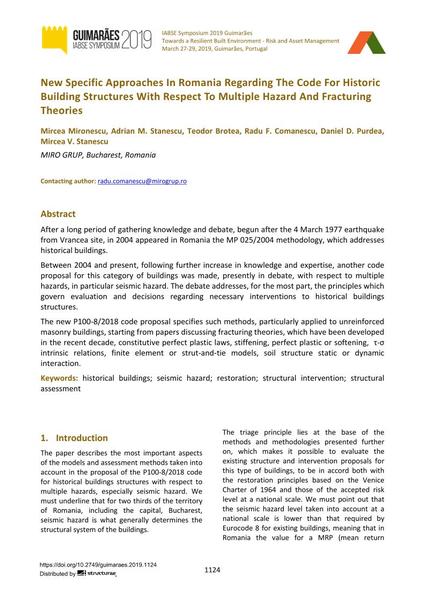New Specific Approaches In Romania Regarding The Code For Historic Building Structures With Respect To Multiple Hazard And Fracturing Theories

|
|
|||||||||||
Bibliographic Details
| Author(s): |
Mircea Mironescu
(MIRO GRUP, Bucharest, Romania)
Adrian M. Stanescu (MIRO GRUP, Bucharest, Romania) Teodor Brotea (MIRO GRUP, Bucharest, Romania) Radu F. Comanescu (MIRO GRUP, Bucharest, Romania) Daniel D. Purdea (MIRO GRUP, Bucharest, Romania) Mircea V. Stanescu (MIRO GRUP, Bucharest, Romania) |
||||
|---|---|---|---|---|---|
| Medium: | conference paper | ||||
| Language(s): | English | ||||
| Conference: | IABSE Symposium: Towards a Resilient Built Environment Risk and Asset Management, Guimarães, Portugal, 27-29 March 2019 | ||||
| Published in: | IABSE Symposium Guimarães 2019 | ||||
|
|||||
| Page(s): | 1124-1131 | ||||
| Total no. of pages: | 8 | ||||
| DOI: | 10.2749/guimaraes.2019.1124 | ||||
| Abstract: |
After a long period of gathering knowledge and debate, begun after the 4 March 1977 earthquake from Vrancea site, in 2004 appeared in Romania the MP 025/2004 methodology, which addresses historical buildings. Between 2004 and present, following further increase in knowledge and expertise, another code proposal for this category of buildings was made, presently in debate, with respect to multiple hazards, in particular seismic hazard. The debate addresses, for the most part, the principles which govern evaluation and decisions regarding necessary interventions to historical buildings structures. The new P100-8/2018 code proposal specifies such methods, particularly applied to unreinforced masonry buildings, starting from papers discussing fracturing theories, which have been developed in the recent decade, constitutive perfect plastic laws, stiffening, perfect plastic or softening, τ-σ intrinsic relations, finite element or strut-and-tie models, soil structure static or dynamic interaction. |
||||
| Keywords: |
structural assessment restoration seismic hazard historical buildings structural intervention
|
||||
